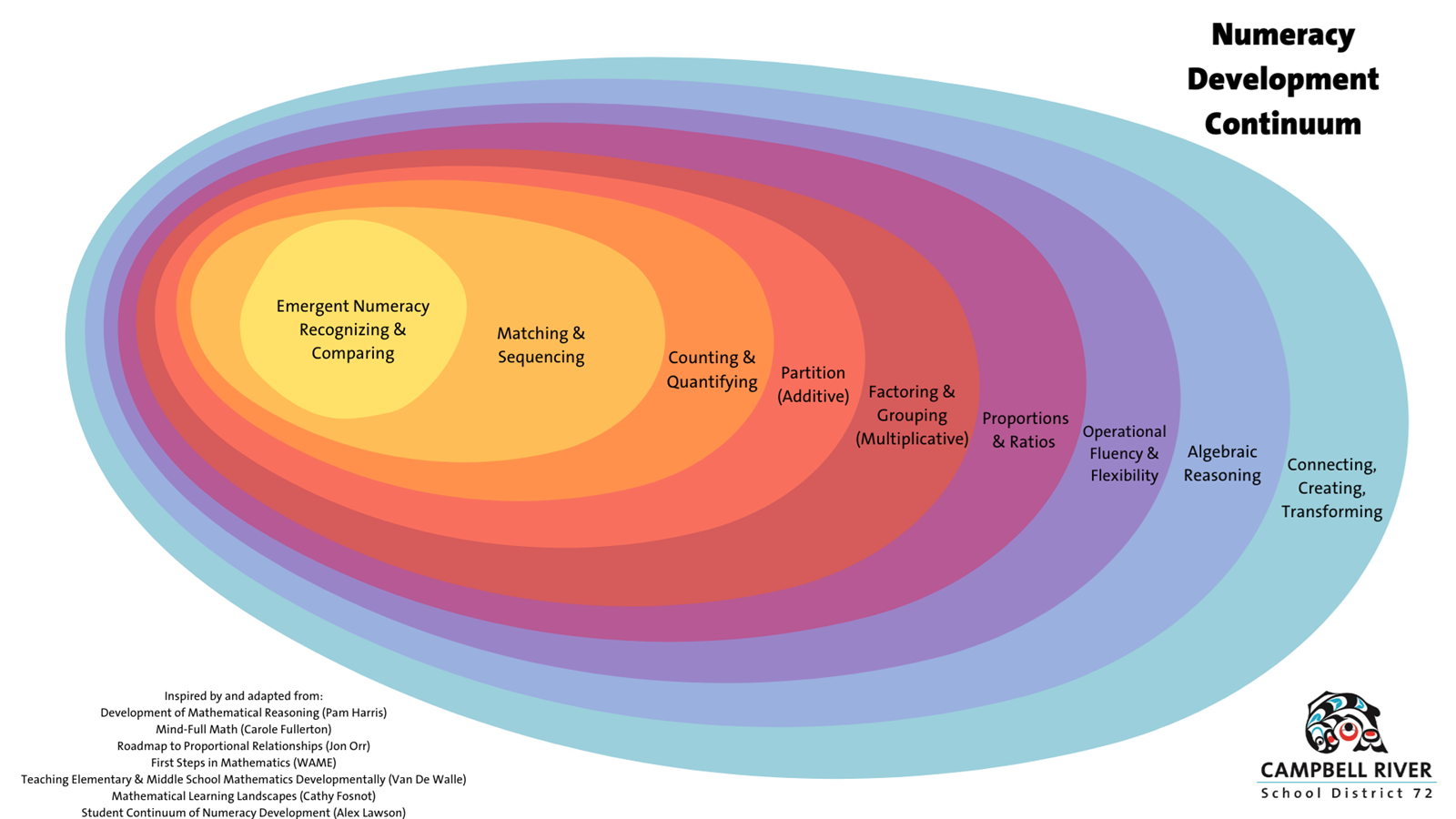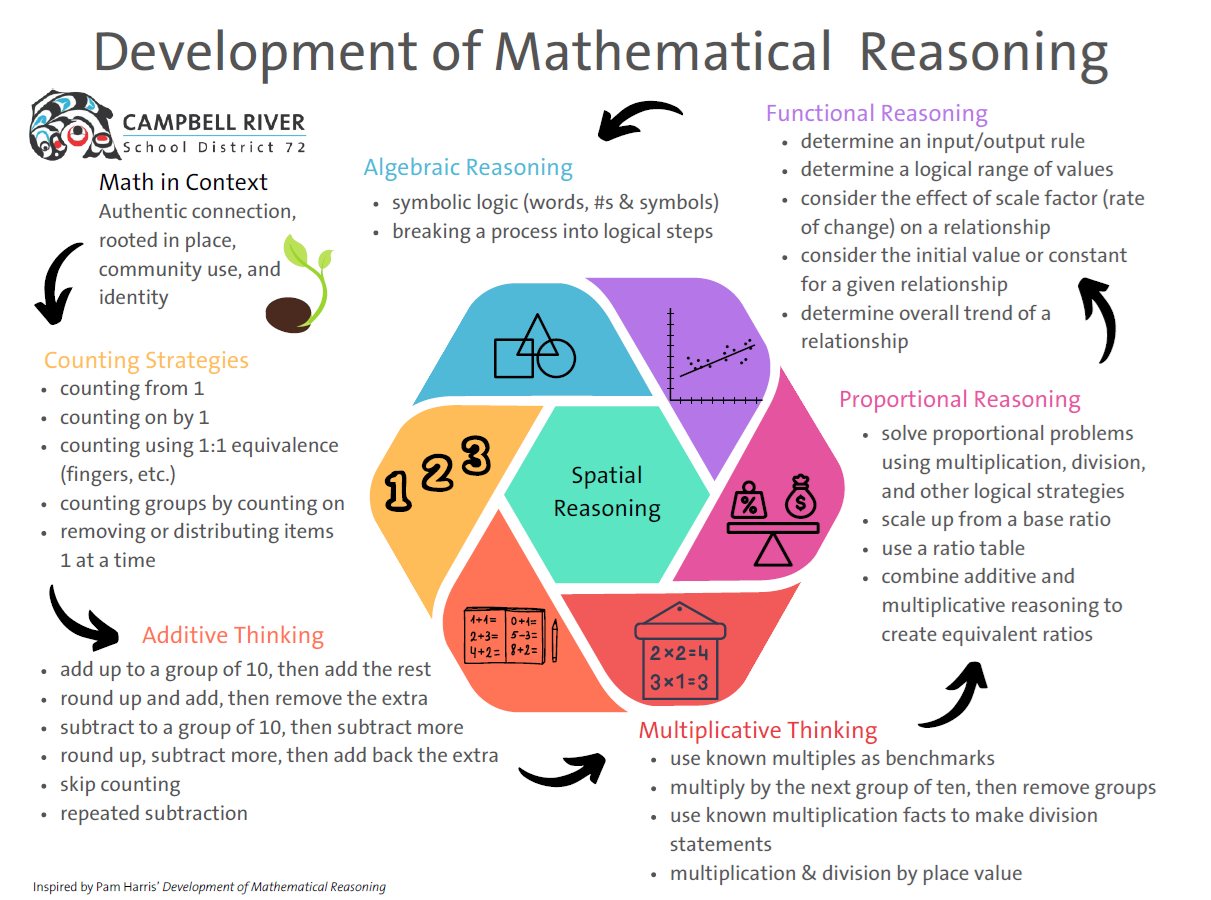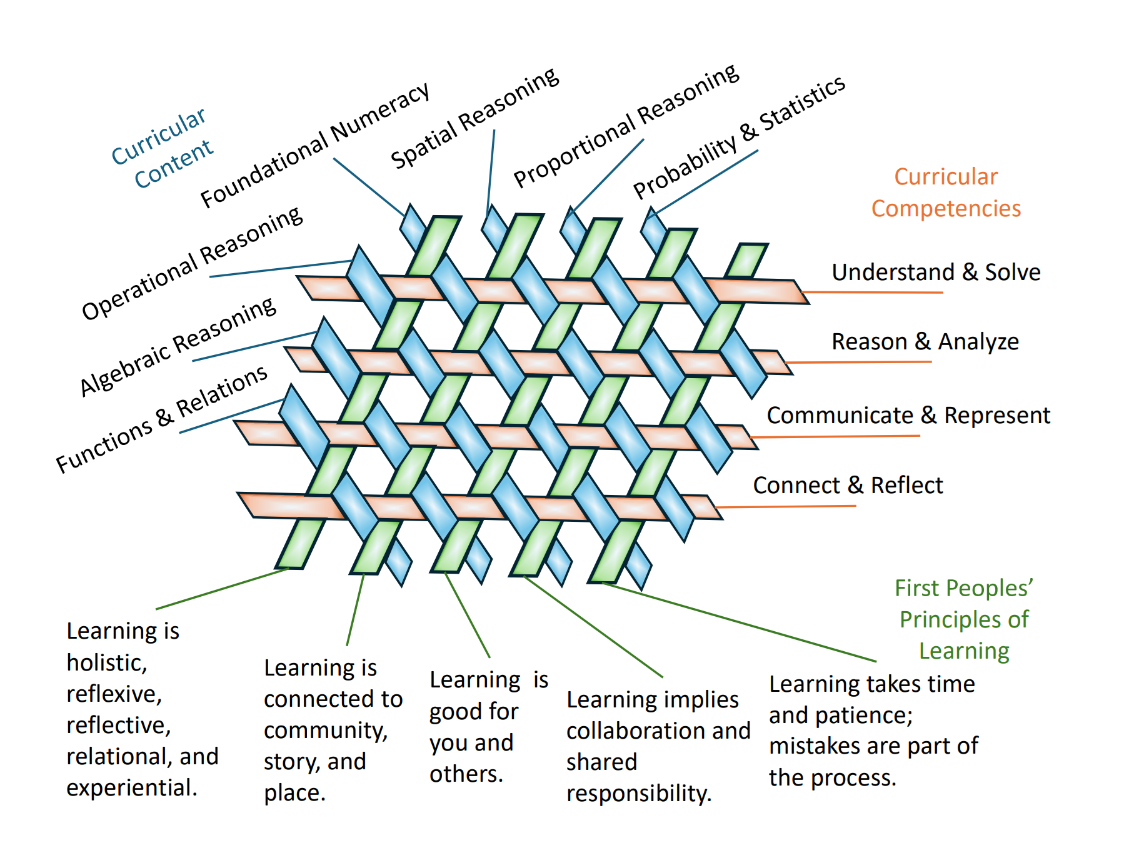III. Conceptual Understanding
Being numerate involves recognizing individual strengths and a variety of perspectives and worldviews. Weaving together competencies, content, and culture demonstrates that mathematics is a growing body of knowledge that is created and used by all people and communities.
Interconnectedness is a foundational principle that is central to the Indigenous people who have been in this place since time immemorial. School District 72 operates throughout a large geographic area. Campbell River and Quadra Island schools and our school board office are located on the traditional territory of the Liǧʷiɫdax̌ʷ people. Our district also encompasses the traditional territory of the Klahoose (Cortes), K’ómoks (Sayward), and χʷɛmaɬkʷu (Bute Inlet) First Nations.
First Nations | Language | Expression | Meaning |
Wei Wai Kum Nation Wei Wai Kai Nation Liǧʷiłdax̌ʷ People | Kwak’wala
| “namwayut” | ‘We are all one’ |
Nuu-chah-nulth | Ehattesaht | “hišukniš ćawaak” | ‘Everything is connected’ |
Tla’amin χʷɛmaɬkʷu (Homalco) Nation Klahoose Nation Kwakwaka’wakw A̱wi’nagwis (Sayward Area) | ʔayʔaǰuθəm (Ayajuthem)
| “ʔukʷs qat̓ᶿɛnxʷɛgəs” | ‘We come together’ |
![]() Understanding & Solving
Understanding & Solving
Learners engage in problem-solving experiences that are connected to place, story, cultural practices, and perspectives relevant to local First Peoples communities, the local community, and other cultures
![]() Connecting & Reflecting
Connecting & Reflecting
Learners incorporate First Peoples worldviews and perspectives to make connections to mathematical concepts
When numeracy skills are applied in real-world, authentic contexts, students make connections between their lived experience and the math they are learning.
Math teaching and learning in SD72 includes diverse perspectives from multiple communities, engages families and schools, and builds local, national, and global connections.
| Resource Description | Link to Resource | |
| 1 | Tri-axial weave model combining curricular content, competencies, and First Peoples' Principles of Learning (K-12): Highlights the integration of culturally affirming practices | Interweaving Math |
| 2 | Nested shell model of numeracy development (K-9) | Numeracy Development Continuum |
| 3 | Infographic (Process diagram): Outlines the stages of mathematical reasoning from counting to algebraic reasoning, beginning with an authentic context and building from concrete to more abstract representations. | Development of Mathematical Reasoning |
| 4 | Rubric-style, multi-grade tables that show the progression of foundational numeracy and operational fluency (K to 9). Each table presents elaborations of mathematical concepts and skills. Helpful for multi-grade planning. | Foundational Numeracy Trajectories |
| 5 | Table mapping the BC curricular competencies for math K-9 in terms of depth of knowledge (Planning and assessment resource for differentiated instruction) | Depth of Knowledge K-9 |
| 6 | Matrix (Table) relating depth of knowledge (DOK) and cognitive rigor in math | Webb Hess' DOK Matrix |
| 7 | "Myself in Math" Self-Reflection (self-assessment template for Grade 6+) | Myself in Math Reflection |
| 8 | Checklist for self-reporting learning habits in math class (Grade 4+) | Math Habits of Mind Self-Assessment |
| 9 | Templates for Number Sense and Operations SNAP assessments (Grade 2 to 9) Customized templates for use in SD72, updated for current BC Math curriculum. The SD72 Student Numeracy Assessment and Practice (SNAP) templates are intended to be used as an instructional routine and formative assessment strategy. The templates can be used at several points in the year, to document growth in number sense and operational fluency. | SNAP Combined Grades 2-9 |
Integrating the Core Competencies and Numeracy
What Are Core Competencies?
Core competencies are sets of intellectual, personal, and social and emotional proficiencies that all students need to develop to engage in deep learning and life-long learning.
 Communication – The communication competency encompasses the set of abilities that students use to impart and exchange information, experiences and ideas, to explore the world around them, and to understand and effectively engage in the use of digital media.
Communication – The communication competency encompasses the set of abilities that students use to impart and exchange information, experiences and ideas, to explore the world around them, and to understand and effectively engage in the use of digital media.
 Thinking – The thinking competency encompasses the knowledge, skills and processes we associate with intellectual development. It is through their competency as thinkers that students take subject-specific concepts and content and transform them into a new understanding. Thinking competencies include specific thinking skills as well as habits of mind, and metacognitive awareness.
Thinking – The thinking competency encompasses the knowledge, skills and processes we associate with intellectual development. It is through their competency as thinkers that students take subject-specific concepts and content and transform them into a new understanding. Thinking competencies include specific thinking skills as well as habits of mind, and metacognitive awareness.
 Personal and Social – Personal and social competency is the set of abilities that relate to students’ identity in the world, both as individuals and as members of their community and society. Personal and social competency encompasses the abilities students need to thrive as individuals, to understand and care about themselves and others, and to find and achieve their purposes in the world.
Personal and Social – Personal and social competency is the set of abilities that relate to students’ identity in the world, both as individuals and as members of their community and society. Personal and social competency encompasses the abilities students need to thrive as individuals, to understand and care about themselves and others, and to find and achieve their purposes in the world.
Source: https://curriculum.gov.bc.ca/competencies
When learners explore the reasonableness or efficiency of a mathematical solution, they can develop notions of ethics, integrity, and respectful communication.
When learners share what they are learning with others, they draw upon prior knowledge, develop their communication skills, acquire specialized vocabulary, and refine their ability to question, reflect and respond to new information.







